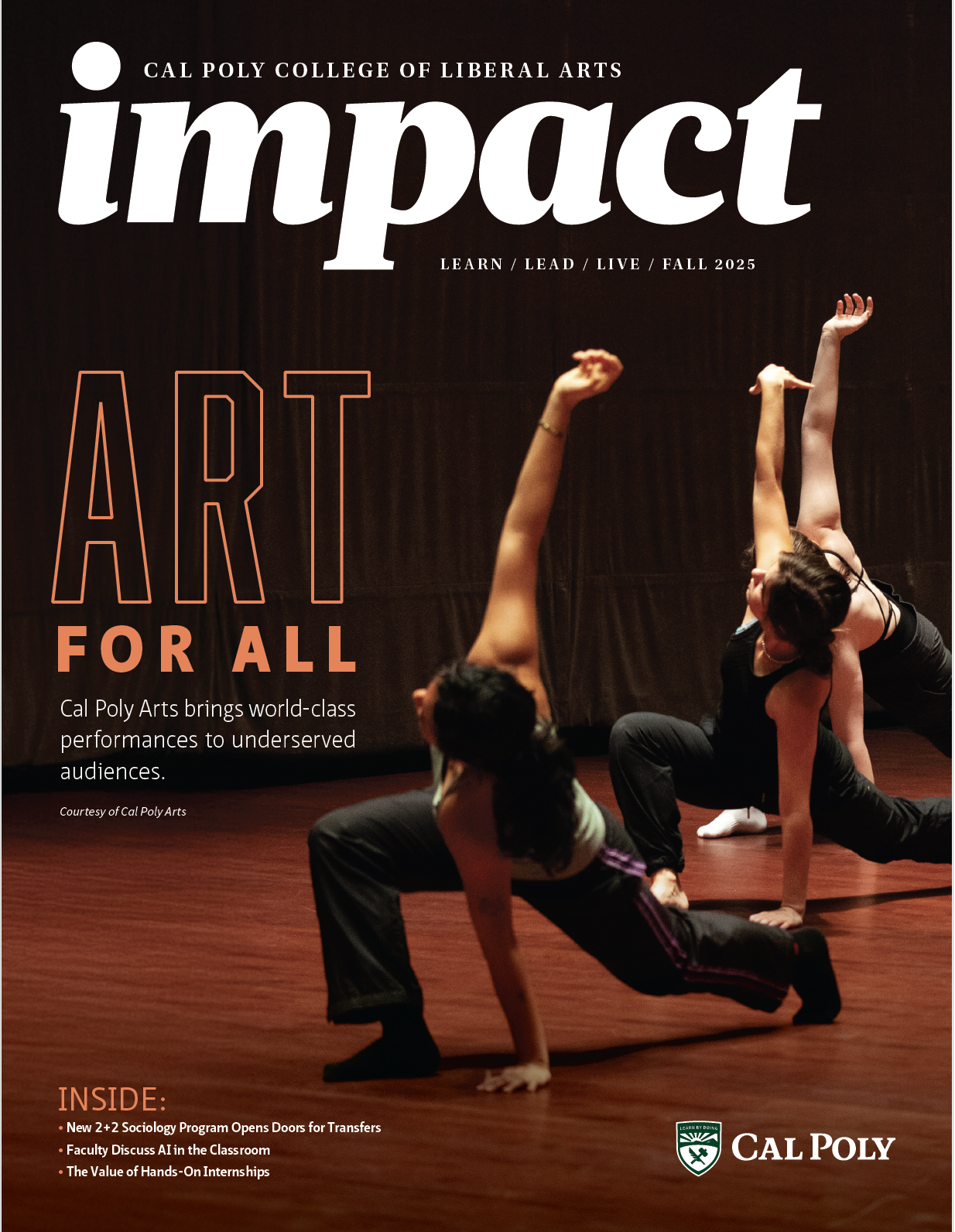Recent News

Cal Poly Spanish Language Debate Team Prepares for Upcoming Competitions
Mar 9, 2022
By Sophie Lincoln

Cal Poly Spanish Debate Team
In 2017, Cal Poly’s Debate Team added a new component for bilingual students to participate in both English and Spanish debates. The debate team is open to students of any major, and Spanish-speaking students can participate in both intercollegiate national debates with the at-large team and in international opportunities with other Spanish-speaking students.
According to Spanish Language Debate Team Coach Marion Hart, this initiative aims to educate, equip and train students in Spanish advocacy, so they can then “advocate for themselves and their communities wherever they are after college.”
For English senior Jenny Doan, who is pursuing a Spanish minor, this opportunity allowed her to both improve upon her Spanish language skills and become a more confident speaker.
“Spanish debate is not your typical Spanish class in which the professor lectures about rules and concepts,” Doan said. “The main objective of Spanish debate is to communicate in the language. In class, we have done exercises to practice our persuasion skills in Spanish, such as finding a random object around our room and convincing someone to buy it.
Doan said the class also offers exercises aimed at improving pronunciation and enunciation in Spanish, including practicing tongue-twisters and reading articles aloud.
“I think that every student who’s studying Spanish at Cal Poly should join the debate team for at least one quarter,” Doan said.
The team focuses on topics that are relevant to the modern world and community, including climate change and immigration policies. The group has also built relations with other Spanish-speaking debate teams both in the U.S. and abroad.
On April 30, the debate team will co-host its second annual Spanish civic debate with Centro de Enseñanza Técnica y Superior (CETYS), a private, polytechnic university in Mexicali, Mexico. This is the only Spanish-language civic debate in the United States, and has a slightly different format than that of traditional debates. “We are going to be debating against each other – so each university is in debates around issues that specifically touched [California and Baja California],” Hart said.
The topic of this year's debate is the ethicality of the Yuma desalination plant in Arizona. According to Hart, the plant is part of international treaty obligations to provide the Mexico with water.
"The creation of the [desalination plant] also inadvertently created a wetland that now protects endangered and threatened species. While the desalination plant has only run three times, every time it has been in operation, the wetland has suffered," Hart said. "But, as we see greater demand for water and less consistency in snow pack, the amount of water in the Colorado that reaches Mexico dwindles."
Hart said she plans to continue expanding the program and have the team participate in as many Spanish debates as possible.
Students who are interested in the debate team can email Marion Hart at mhart03@calpoly.edu.
Read the most recent CLA News stories

Music Lecturer John Astaire Shares His Lifelong Passion for Music with the Community
Mar 7, 2022

Lecturer John Astaire has taught
at Cal Poly for nearly a decade.
By Nicole Troy
Before he could even speak, John Astaire was pulling pots and pans out of the kitchen cupboards and making music.
Now a professional percussionist, the Cal Poly Music Department lecturer is sharing his lifelong passion for music with others.
“I never thought teaching was something I’d do,” Astaire said. “But when the opportunity came to teach at Cal Poly, I took it and I just love it. I love sharing music with students and people. I love talking about it. I love teaching it. It's just fun.”
Astaire has been teaching percussion and music theory at Cal Poly for nearly a decade; though, his initial passion for music began much earlier.
“When I was a little kid, I just started drumming,” Astaire said. “It was just sort of instinctive, and it was one of those things where I never really considered anything else in my life except for doing music.”
Astaire’s family has deep roots in the entertainment and creative industries with his grandfather being Hollywood icon Fred Astaire and both his parents and siblings dabbling in artistic expression from drumming to oil painting to dance to guitar.
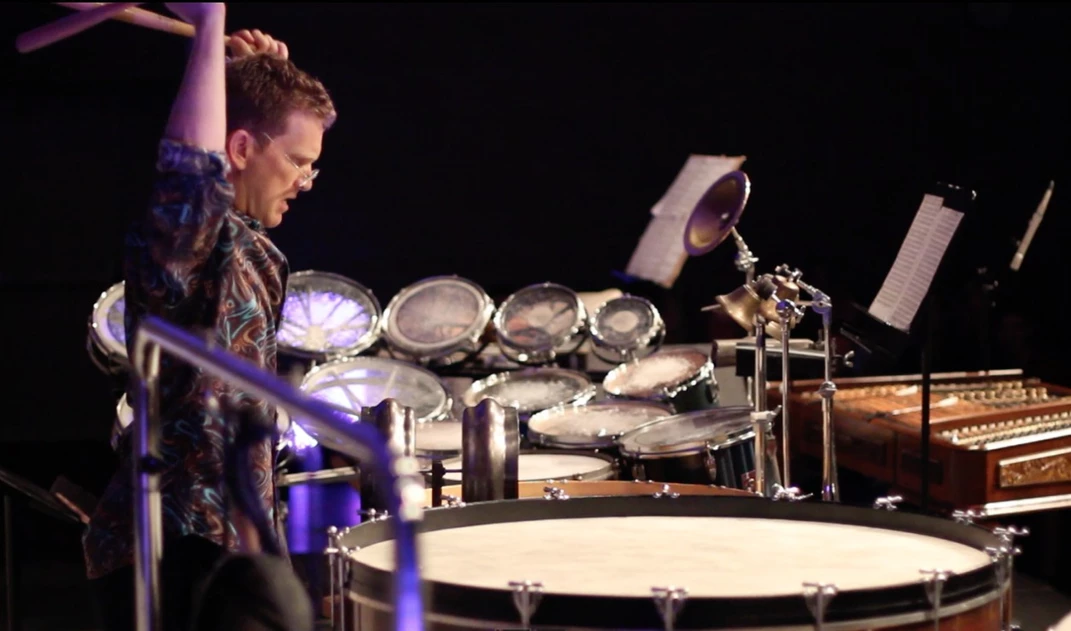
Astaire performing Performing Poul Ruders'
Towards the Precipice
“I guess there are some musical genes in our family,” he said. “But I mean, I'm the only one of my siblings that I think started banging on things before they could talk.”
A Central Coast local, Astaire attended San Luis Obispo High School before moving on to Cuesta College and graduating with his bachelor’s degree from Cal Poly in 1998.
Though music was a major driving factor in his life, Astaire was never sure he wanted to major in it or even attend college. That was until former Cal Poly Band Director and Music Professor Emeritus Bill Johnson recruited Astaire to play for the Cuesta College Wind Ensemble and pursue an education at Cal Poly — something that would change his life forever.
“Bill kind of dragged me into playing at Cal Poly, but there were two teachers there that really shaped my life as a musician,” Astaire said.
The first of Astaire’s role models was Ken Watson, who Johnson used as a selling point to convince Astaire to attend Cal Poly. Watson had just retired from the University of Southern California and was a “big time studio musician in the 70s and 80s.”
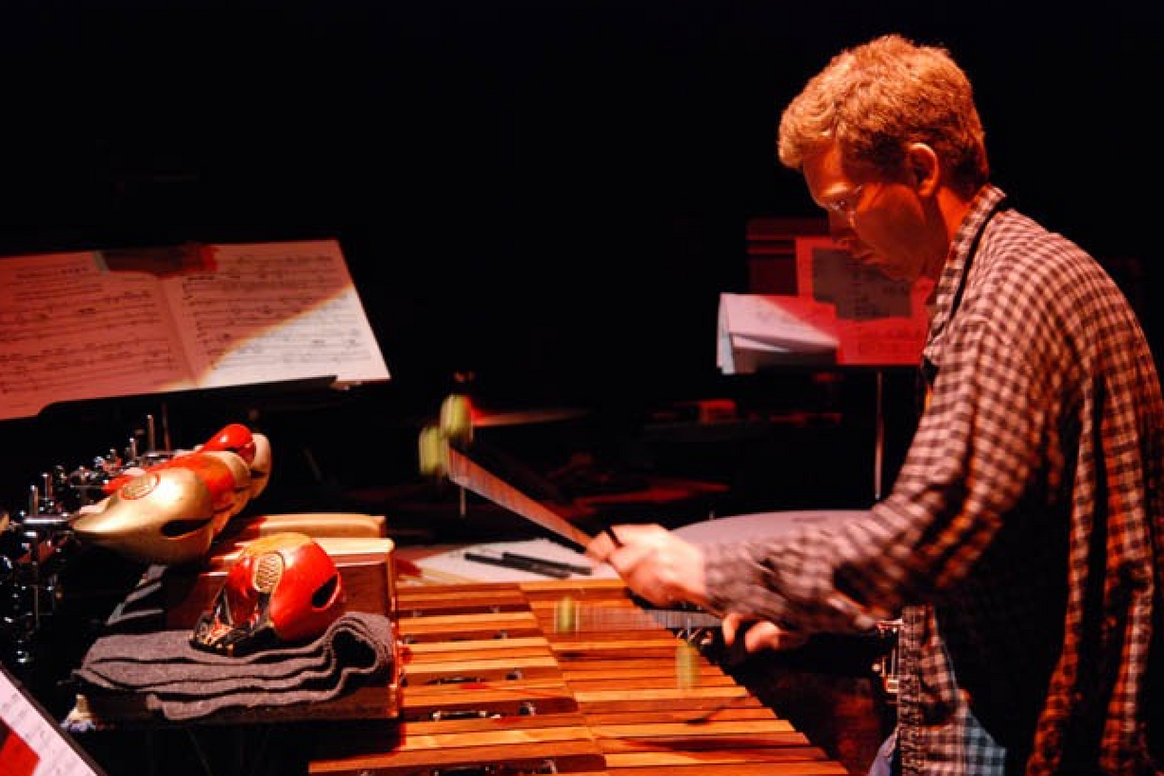
Astaire performing Louis Andriessen's
"Woodpecker" on a percussion instrument.
“Ken taught me an incredible amount about the practicality of music making and what it takes to really be a percussionist. Not just a drummer, but a well-rounded percussionist,” he said.
The next great influence was Astaire’s piano instructor, Professor Emeritus John Russell.
“John taught me how to be a full musician. His composing was very profound and deep, and his teaching taught me to interpret and play Brahms' late piano works which really made for a lifelong learning experience,” Astaire said.
Armed with knowledge from two musicians Astaire credits as heroes, he moved to Indiana after graduation to pursue both a master’s and a doctorate degree in music from Indiana University.
After studying and working in Indiana for nearly a decade, in 2012 Astaire decided it was time to come home, which coincided perfectly with a job opening for a percussion instructor at Cal Poly.
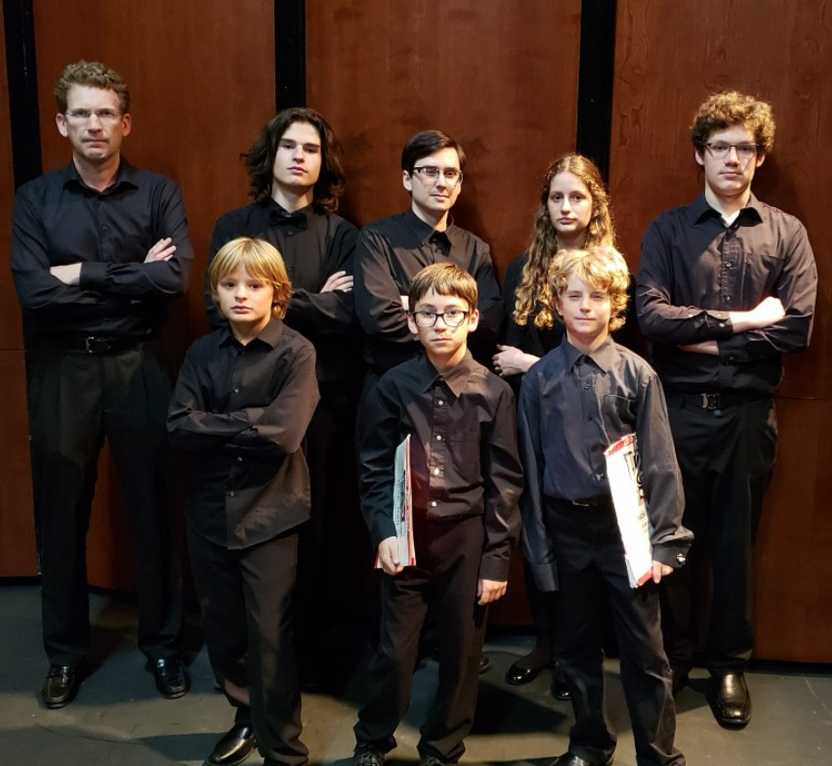
Astaire poses for a "serious" photo with
members of the SLO County Youth Symphony.
Once back home in San Luis Obispo, Astaire quickly became affiliated with the local music scene and became active in several local ensembles including the San Luis Obispo Symphony Orchestra, Opera San Luis Obispo, Orchestra Novo, the Santa Maria Symphony, the Lompoc Pops Orchestra, Symphony of the Vines, and the San Luis Obispo Master Chorale. He also serves as the orchestral percussion coach for the San Luis Obispo County Youth Symphony, where he helps shape the next generation of performers.
Alongside his work in the community, Astaire took over leading the Music Department’s percussion ensemble, Polyrhythmics.
“Taking over the ensemble was part of my teaching duty and when I started it only had four people in it. I was able to grow it to more than 30 people at its height before COVID,” Astaire said.
Though Astaire did not originally set out to teach, his work throughout the Cal Poly Music Department and San Luis Obispo County reflects the impact he has made on the Central Coast music scene.
More recently, his musical impact has grown even further with the release of his first pop record, “Dreams,” which is available across all major music streaming platforms.
“[Dreams] was kind of a big hill to climb for me, because I had written these songs, but I'm not a singer and these are songs that needed to be sung,” Astaire said.

The cover art of Astaire's first pop
record "Dreams".
Astaire tapped his friend, and fellow Cal Poly alumnus, Alex Wong to produce the EP and assist with the arrangements. As producer, Wong was able to persuade Astaire to sing on the album — which he was initially unsure about.
“I was so insecure about it. I even told Alex that we may have to hire somebody to come in and sing these tunes and he was like, ‘No way these are your songs. You have to sing them. Just trust me,’” Astaire said. “And I did. I put myself in his hands and I'm very happy with the results. I can't believe how good it came out.”
Astaire has two more records in the works: an instrumental progressive jazz/rock fusion record coming out next year and another pop album collaboration with Wong that will be released the following year.
Until then, Astaire’s next plans are simple: build, create and teach.
“My next goals are to build up a library of actual releases, keep creating music, and I want to continue to teach at Cal Poly — I like what I'm doing,” Astaire said. “For me, it's a privilege to get to teach. I think what every [music] teacher wants, ultimately, is to have their legacy be to produce students in which you have a part in shaping their lives musically.”

Mustang Band, Cheer and Dance Teams Bring the Beat — And Pizzazz — to San Francisco’s Chinese New Year Parade
Mar 2, 2022

The Cal Poly Colorguard and Mustang Band march
through downtown San Francisco during the
Chinese New Year Parade.
As fireworks popped and crowds cheered, Cal Poly’s Mustang Band and the university’s cheer and dance teams marched among brightly colored floats and dragon dancers as they helped celebrate the Year of the Tiger at the Alaska Airlines Chinese New Year Parade in San Francisco. The parade, which returned on Feb. 19 after a pandemic hiatus in 2021, marks the marching band’s seventh time participating in the Lunar New Year celebration.
Preparations for the parade began a month in advance: each Sunday consisted of lengthy music rehearsals, drills on marching technique and laps in formation to build endurance. Training was challenging — but worth it — to pull off a spectacular show.
Once in San Francisco, the performers began the day with a friendly tradition: jamming with the UC Davis Marching Band in front of the landmark Ferry Building on the San Francisco Embarcadero. Drum major Natalie Tokhmakhian, a third-year electrical engineering student, said the gathering helped set the tone for the night as each band tried to out-play the other.
“Not only was it a great way to convey the energy and excitement that the bands had for the parade,” she said, “but we also had many supporters and fans come out and enjoy the music!”

Members of the Mustang Band jam in front of
the Ferry Building before the start of the
Chinese New Year Parade.
More than 200 musicians and dancers clad in green and gold took to the 1.3-mile parade route past Union Square and Chinatown. Mustangs played Cal Poly's signature drum cadences mixed with lively standards like Bruce Channel’s “Hey Baby.” The musical performance was dotted with “Georging,” exuberant choreography and interaction with fans unique to Mustang Band.
“It's a balance between chaos and order,” says color guard member Clara Hickox, who marched in the parade for the second time this year. “One minute we're all running around or interacting with the crowd — and the very next second we are all in line marching the same exact step at the same time, ready to perform a song.”
Tokhmakhian and the other drum majors led the march while wowing the crowd with spins, tosses and behind-the-back passes of the mase, the ceremonial baton. She said her most memorable moments of the parade came when performing a cadence called “Tik-Tok,” which allows for sections of the band to briefly fall out of the parade block to show off their top-notch dance moves.
“A personal favorite is called ‘The Proposal,’ in which the drum majors would run up to a random audience member and ask, ‘Will you marry me?’’ recalled Tokhmakhian. “The crowd reactions were priceless!”
During another part of the parade route, Emma Jorgenson, third-year architecture student and saxophone section leader, remembers making the night of a young spectator.
“We were on a narrower portion of the street, and there was a dad holding his daughter up so she could take a picture,” said Jorgenson. “At that moment we called the move ‘Panic,’ when we stay in the block until the last possible second and then run around screaming until we have to be back in marching formation. It was really fun to be able to single her out and really make her feel a little bit special.”

The Mustang Band plays well into the night
marching through the parade.
Mustangs said the energy of the crowd and the thrill of performing under city lights to celebrate the holiday motivated them to do their absolute best following the parade’s 2021 hiatus.
“Everyone was so excited to see us,” Hickox said. “I've never had so many cameras on me! We represent Cal Poly so we had to be at the top of our game performance-wise. It's so rewarding and fun to be received so positively by the people.”
According to Cal Poly’s Music Department, the parade began in the 1860s as a means for Chinese community in San Francisco to educate and share their culture with the greater community. The parade and festival have grown to be the largest celebration of Asian culture outside of Asia. Today, it has emerged as one of the top 10 parades in the world by the International Festivals and Events Association.
“For Mustang Band this is a chance to be a part of something that can be a tradition for people’s Lunar New Year celebrations, and I think that’s really special,” said Jorgenson. “It’s also a chance for us to bolster a community other than our own with something that really is joyful and happy in a world where it’s hard to find that joy sometimes.”

A flute player marches in formation during
the Chinese New Year Parade.
The band represents 220 members from different academic disciplines who spread Mustang spirit at about 50 occasions on campus throughout the year, including athletic events and university functions. Unique experiences, like the Chinese New Year Parade, stay with each member long after the last firework explodes and the confetti is swept up.
“To me personally, being a part of something so unique to the Mustang Band is really fun,” said Hickox about the parade experience. “We all put in a lot of work to make a good, cohesive performance, and being in San Francisco at this huge event means a lot to everybody in Mustang Band.
“It's about coming together and making something worth remembering and passing on to the next generation of Cal Poly students.”
Still looking to catch the parade? Check out the parade’s Facebook page for the livestream video. Cal Poly appears at the 1:02:30 mark.

CLA lecturer named First 5 SLO County’s January “Hands-on Hero @Work”
Jan 27, 2022

Christina Lefevre Latner began her work
with the Chamber in October 2021.
By Nicole Troy
Women’s, Gender and Queer Studies Department Lecturer Christina Lefevre Latner (MPP, '14) was named First 5 San Luis Obispo County’s January “Hands-on Hero @Work” for her role as Workforce Development Manager with the San Luis Obispo Chamber of Commerce.
Lefevre Latner received the distinction in recognition of her work spearheading the Family-Friendly Workplace Accelerator Program, which provides resources and support to SLO County businesses to help foster a strong local workforce through family-friendly policies.
“I am really excited to be the first one kicking this off, and I definitely feel honored by that, but this is also a great opportunity to talk about why family-friendly workplaces are so important,” Lefevre Latner said.
The Family-Friendly Workplace Accelerator Program, supported by investment from both the County of San Luis Obispo and First 5 San Luis Obispo County, strives to provide businesses with simple practices to attract and retain employees, improve employee satisfaction through work-life balance and strengthen productivity. Policies include, but are not limited to, flexible scheduling, accommodations and support, health spending accounts and childcare support.
“The two policies that I am currently focusing to educate businesses on their benefits are flexible scheduling and telecommuting,” Lefevre Latner said. “There are a lot of companies right now who are on the fence thinking, ‘Do we continue how we've been working since COVID, or do we go back to normal?’ I'm hoping nobody goes back to normal because normal wasn't working for a vast majority of us.”
A 2013 Pew Research Study found that among working parents with children under age 18, more than half say it is difficult to balance their work and family life, and half of all workers feel they could do their job better if allowed more flexible schedules.
As a mother of two caring for an aging parent, Lefevre Latner finds herself advocating for policies that she has extensive personal experience with.
“I'm kind of a perfect example of how family-friendly workplace policies can bring people into positions that are perfect for them that they wouldn't necessarily be able to do if it were a strict 9–5 desk job,” Lefevre Latner said. “I work from home most of the time, and while I work during core hours where I can, there is flexibility if I need to pick up my kids from school or help get lunch for my mom, who is 88 and suffers from dementia. I'm able to stay home with her, rather than having a caregiver come in all the time, which is extraordinarily expensive, if you can even find one. There have been shortages in caregivers throughout the pandemic for all ages, from infants to the elderly.”
Throughout Lefevre Latner’s impressive 20-plus year career in areas including policy analysis, implementing services and consulting, she says the ethos of her career has often been, “removing barriers to access for marginalized groups.” That idea is both present in the program with the Chamber and something she discusses heavily with her students.
“Because my background is in policy, I teach my class using a feminist policy analysis framework. I want students to really understand how institutions have caused these different types of inequality, not just for women but for other marginalized groups, and how you can then change them to become more equitable,” she said.
Lefevre Latner has lectured at Cal Poly for seven years and says her interest in work regarding family-friendly policies “partially sprung out of conversations with my students.”
“One of the big topics we talk about is women in the workforce and things like the pay gap, the broken career pipeline and choices. In talking to many of my students, I found that for many of them they considered how their career choice would impact their ability to parent, and often it impacted their decisions,” Lefevre Latner said. “While I was teaching and having these conversations with students, I began work with First 5 to develop an advocacy platform which was informed by what I had learned from student experiences.”
The job opening at the Chamber sprang from this early work and allowed Lefevre Latner to combine her policy experience, conversations with students and background consulting for First 5 on their Family-Friendly Workplace Toolkit into one meaningful position.
Within three years, Lefevre Latner hopes to have 100 local businesses incorporate at least one family-friendly policy.
“There is always more that can be done to support families and others in the community, and even though they are called family-friendly workplace policies, a lot of these policies are ones that will benefit — not just parents or children — but it will really benefit everyone,” Lefevre Latner said.

Political science student uses trip abroad as senior project research
Jan 14, 2022

Hollar spent three weeks on the
remote farm of Dalö Tsána.
By Nicole Troy
As spring quarter of 2021 wrapped up, political science senior Denae Hollar began preparing for her upcoming trip to a remote farm in Costa Rica. Originally planned as a volunteer trip, Hollar started thinking about how she could use this experience as research for her impending senior project on democracy and global food security.
“I was already really interested in learning more about global food security, and it happened to be a coincidence that I was going to Costa Rica to volunteer on a farm,” Hollar said. “I had the idea, so I talked to my advisor Shelley Hurt on how I could turn this [trip] into a field observation.”
Under a time crunch, Hollar quickly approached Associate Professor Shelley L. Hurt on how she could use this experience to answer the complex question: How can the developing world achieve food security in the 21st century?
According to Hollar, the consensus among political science scholars is that increasing technology in agriculture and opening food trade markets are the most effective ways to combat global food insecurity.
“My research aimed to distinguish the holes in the leading consensus accepted by political science scholars,” Hollar said. “Though it’s not the end all be all, I believe democracy is a vital aspect in improving food security."
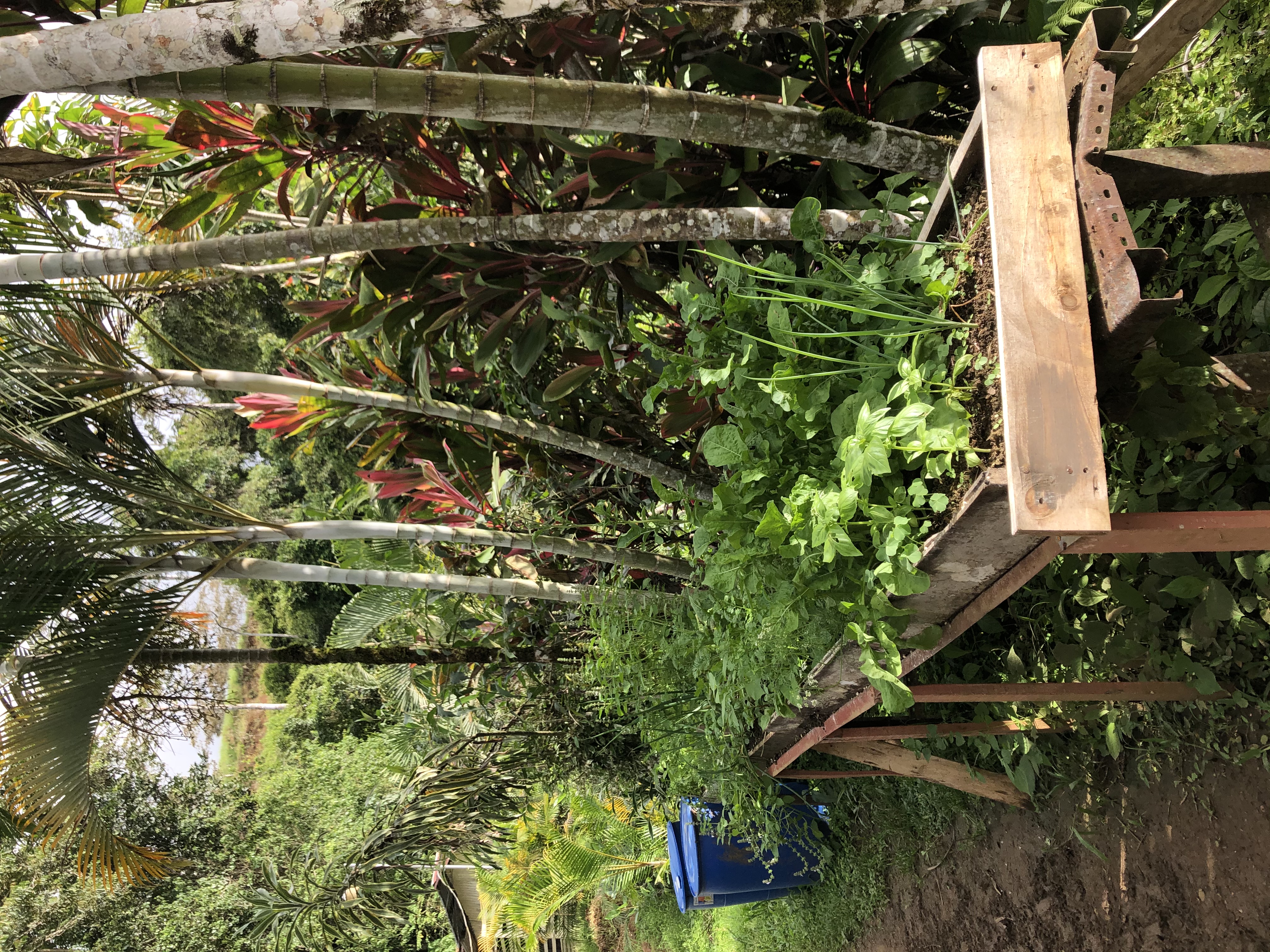
For three weeks, Hollar worked four hours per day on the remote farm of Dalö Tsána, located deep in the mountains of Costa Rica, nearly 45 minutes outside of the closest city of Turrialba in the Cartago Province.
“Every morning I would wake up to the music of birds singing and insects buzzing,” Hollar recalled. “The farm was located on top of a hill, overlooking a deep valley of thick green jungle. As you would expect, the view was incredible."
Each day Hollar and her fellow international volunteers from the World Wide Opportunities on Organic Farms (WWOOF) network worked on the farm completing tasks like tending to plants, maintaining the nursery and scrubbing moss from non-indigenous trees.
After work, the volunteers would gather and make a family-style dinner together from the produce and herbs on the farm.
“Our meals were very intentional. We were able to use what produce we had, and a lot of creativity went into that. We had volunteers from Italy and Mexico, and they brought their own twists. Food is more than sustenance; it has a communal and cultural aspect,” Hollar said.
Throughout her trip, she reflected on many personal takeaways.
This trip reminded me of how similar we all are as human beings,” she said. “On the farm, there were individuals from a handful of other countries, and despite cultural differences we all were a cohesive group because we put first love and respect.”
Alongside her personal takeaways, the underlying educational lessons were key to informing her capstone project.
“The biggest thing I observed while in Costa Rica was the paradox of being in an agriculturally rich land, yet many of the people there do not have adequate access to food or they rely on processed food to sustain themselves,” Hollar explained. “This paradox is a repercussion of countries like Costa Rica being a cash crop economy.”
Seeing, working and tangibly experiencing how life was on the farm provided Hollar a rich environment from which to draw conclusions. Instead of authoring a traditional paper on her findings and experience, Hollar worked closely with Hurt to put together a presentation and panel discussion featuring Julie Kurtz, research analyst and sustainability chair at the International Food Policy Research Institute (IFPRI) in New York; Katherine Lane, Cal Poly alumna, educator on food security in South America and founder of SLO’s Farm Link Project; and Isabella Abelgas, Master’s in Public Policy student and first place winner of the 2021 CSU Research Competition for a project entitled, “Impact of Export Crops on Developing Countries.”
Hollar’s presentation and discussion, titled “Challenges and Opportunities for Achieving Global Food Security in the 21st Century,” lasted more than 90 minutes and touched heavily on how most of the food in the world is grown and eaten locally, yet countries without democratized food systems — like Costa Rica — suffer food insecurity the most.
“The biggest anecdote and impression I got from her research findings was the idea that farmers on the ground were engaged in a collective, public and democratic enterprise,” said Hurt. “They were sharing their knowledge and sharing seeds and really trying to activate around this idea of democratic processes and all being held accountable.”
A major data point from Hollar’s presentation stated that, “small farmers produce up to 70% of the world's food, and 90% of that food is consumed where it is produced.” She explained that this data point shows how small, domestic farmers in developing countries are a critical component to feeding the populations of their own countries.
“Democratic institutions have the potential to create more equity and empowerment for small farmers over industrial farmers in developing countries that mostly specialize in cash crops,” Hollar said.
Hollar saw this play out firsthand in Costa Rica, observing that most of the fruits and vegetables available for purchase were not in grocery stores but rather in small produce stands run by farmers and families.

“You can see that Denae’s on-the-ground experience, even though it was on a small scale and anecdotal, taught her the importance of being able to nurture, facilitate and respect the traditional knowledge of these farmers and their processes to grow food for local consumption,” Hurt said.
The 3-week trip left a profound impression on Hollar, and she says she hopes to return to Central America soon.
Hollar plans to take a gap year after graduating in December 2021. During that time, she intends to study for the LSAT to pursue law school while also, “taking any and every volunteer opportunity available in San Luis Obispo.”
In 2023, she plans to attend law school to pursue further opportunities in domestic and global food policy, a sure way to continue following her passion and making a difference across the globe.

English student Avi McManus helps lead Cal Poly Rose Float team to victory
Jan 13, 2022
The addition of marketing skills and an outside perspective on technical problems created a winning combination
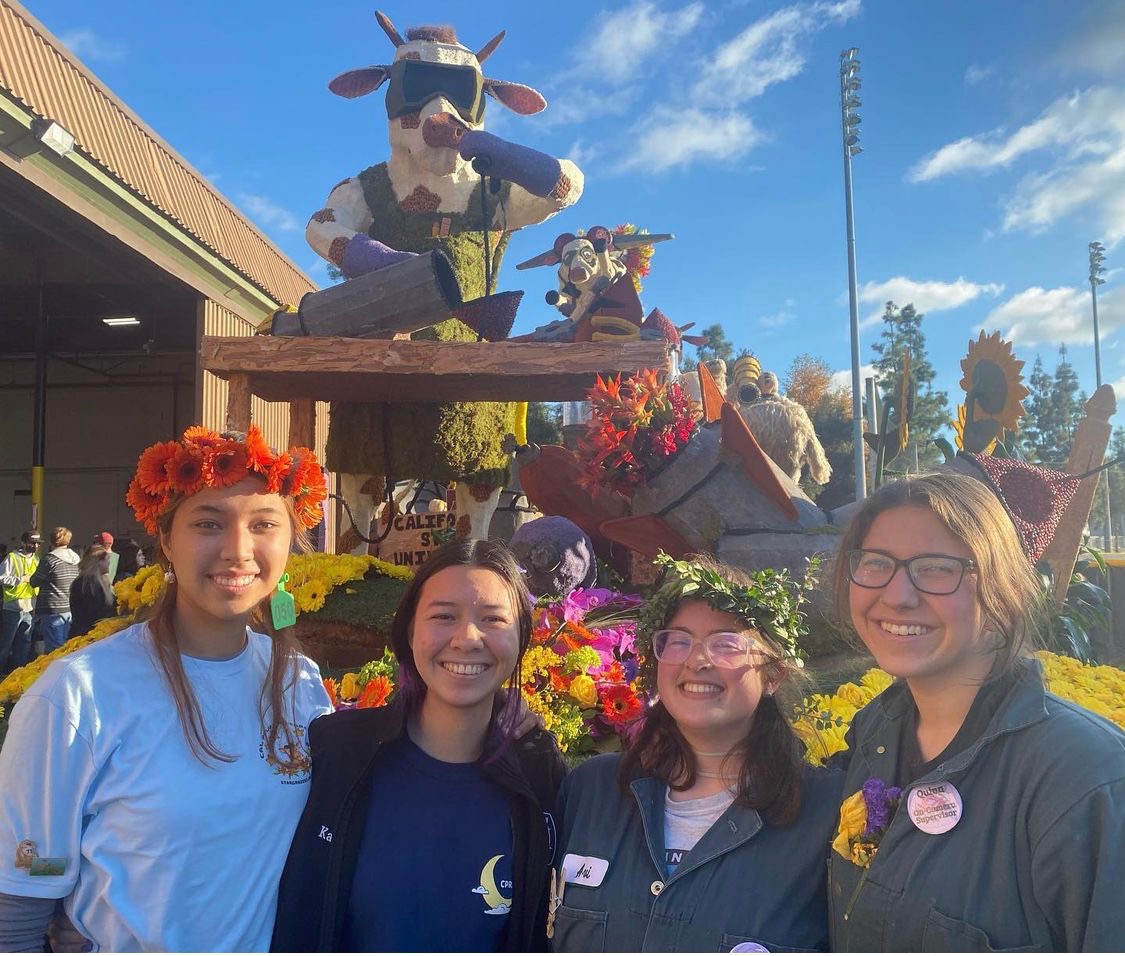
Avi McManus (third from left) poses for a photo
in front of the award-winning float.
By Nicole Troy
Fourth-year English student Avi McManus played a key role in leading the 2021-2022 Cal Poly Rose Float team to victory last week at the 2022 Rose Parade® in Pasadena, acting as the San Luis Obispo team’s vice president. The Cal Poly Rose Float is a joint effort between the two Cal Poly campuses: San Luis Obispo and Pomona.
While this marks the first time in more than five years that a CLA student has held a leadership position on the San Luis Obispo team, McManus’ accomplishments come as no surprise to Cal Poly San Luis Obispo Rose Float Coordinator Josh D'Acquisto.
“It’s one of those things that, yes it’s rare, but the Cal Poly Rose Float team is open to all majors,” D’Acquisto said. “I would probably venture a guess that it has been five to seven years since we’ve had a CLA major in leadership, but we don’t get locked too into major. I am less concerned about what academic school you belong to as we are here to help you succeed in the role you are in.”
D’Acquisto attributes McManus’ success on the team to their hard work and exceptional writing skills.
“This is Avi’s third year in the program now, this time as the vice president, and they are certainly beginning to tap into their English major skill set through writing press releases and working on the copy for the Tournament of Roses media,” D’Acquisto said.
McManus began their Rose Float experience as a volunteer on the construction team in fall 2019, learning the safety and basics of welding on day one. Shortly after, the 2020 Rose Float President Madison Toney told McManus that they wanted to create a new marketing position, something to which McManus was instantly drawn.
“I thought that seemed perfect for me as the person who knows how to write on the team, so I applied for that position and that's what I ended up doing,” McManus said. “Unsurprisingly, that's not a super popular position on Rose Float because people want to do all the mechanical stuff. So, this year I ended up as vice president and then I still do a bunch of the marketing stuff when I have the time.”
From working on the float to booking hotel rooms to coordinating carpools to writing news releases, McManus spends nearly 20 hours per week volunteering, which grows tremendously depending on the time of year. During the school year from February to October, McManus says they spend about five hours per week with Cal Poly San Luis Obispo Rose Float President Regina Chapuis in meetings and then a few hours each Saturday working on pieces of the float.

However, the end of fall quarter looks a bit different. “We usually work between 6 a.m. to 10 p.m. every Saturday. But the design and decoration weeks are two weeks in November and December where, frankly, we work 16-hour days for the whole week,” McManus said.
Due to the arduous time commitment, McManus says that the San Luis Obispo team is “historically very close.”
“These are my closest friends and I actually live with a couple of people from Rose Float. The experience is like work and social time all at once,” McManus explained.
Alongside the comradery the San Luis Obispo team forms, one of McManus’s favorite parts of Rose Float is the interdisciplinary learning opportunities and ability to collaborate.
“Something in which I have fun is that I can ask the obvious questions. My friend Annie is sometimes working on a system that isn’t cooperating and I can stand there and say stuff like, ‘Well, have you tried turning it off and on again,’” McManus said. “Now, that doesn't always work. But sometimes the perspective of someone who just doesn't know what's going on can be strangely helpful when others are so deep in the work.”
The challenging labor and time commitment often pay off as the Cal Poly Universities Rose Float, the only student-led float in the Tournament of Roses, usually takes home awards for their extraordinary production. While competing against professional float builders with budgets nearing $1 million, the team has been awarded 61 trophies over the last 72 years commending all parts of the floats from hydraulics to animation to floral effect.
“They don’t receive much for doing this, and they certainly aren’t getting paid,” D’Acquisto said. “They’re in it because of the drive to do this and see it go by on Colorado Boulevard and say, ‘I was a part of that. I built that.’”

Courtesy: Tom Zasadzinski
This year’s float, “Stargrazers,” featured a scene from the classic Mother Goose nursery rhyme “Hey Diddle, Diddle” and included an engineering feat of a mechanical cow “jumping” over a moon which McManus called, “an amazing piece of performance art.”
“Something people don’t know about the day of the parade was that the judges arrived about a half hour early and Annie Doody, our animations operator, had to rush to start the animations engine without the prep time she normally would have had,” said McManus. “Clearly it went okay though!”
The team ended up securing the Animation Award which recognizes the most outstanding use of animation across the competition. It is the first time that the team has received the designation since the award names were changed in 1984.

After a year of hard work, dedication and perseverance, McManus was overjoyed to witness the team’s hard work travel down Colorado Boulevard.
“Overall, building Stargrazers was such an amazing experience and I'm so proud of what my team was able to do,” McManus said.

Ethnic Studies Department Welcomes Three New Faculty Members In DEI-Focused Cluster Hire
Dec 2, 2021
By Sophie Lincoln
In 2021, the Ethnic Studies Department welcomed Assistant Professors Dan Castilow, Lydia Heberling and Ryan Buyco as part of CLA’s 2021-22 DEI-Focused Cluster Hires. This search was designed to attract a diverse group of academics invested in inclusive teaching and dedicated to scholarly contributions in this area. All have been involved in diversity, equity and inclusion efforts in their departments, our college, the university and in the community.
Dan Castilow
Dan Castilow’s areas of expertise are in Black masculinities, racism and antiblackness in leisure culture. Specifically, Castilow’s research has focused of these concepts within the middle class of Trinidad and Tobago, but he is currently in expanding it to include the same concepts within Black communities of the southern United States.

Dan Castilow
Before coming to Cal Poly, Castilow earned his Ph.D. in anthropology from Tulane University and his BA in international studies from Morehouse College. Previously, Castilow was also a recipient of the Southern Regional Education Board Doctoral Fellowship, and he was awarded a Fulbright Fellowship to complete research in Trinidad and Tobago.
According to Castilow, the interdisciplinary aspect of teaching ethnic studies is what he finds most rewarding in his classes.
“During an academic quarter, students might read historical texts, ethnographic texts, literature and poetry,” Castilow said. “The interdisciplinarity allows students with varied interests to engage in the class, and it also challenges all of us to approach key questions in Ethnic Studies from different perspectives.”
This quarter, Castilow is teaching Introduction to African American Studies (ES 254), but he hopes to later be able to offer a course on Black masculinities and possibly a future study abroad course in Trinidad and Tobago.
Lydia Heberling
Lydia Herberling’s areas of expertise are in American Indian literatures, with a focus on the literatures from Indigenous California, as well as the emerging field of critical surf studies. Her most recent work focuses on aesthetic and formal innovations in twentieth and twenty-first century California Native literatures. She is currently working on an article that examines the relationship between colonialism, catastrophic waters and surfing in three creative non-fiction works by Indigenous writers.
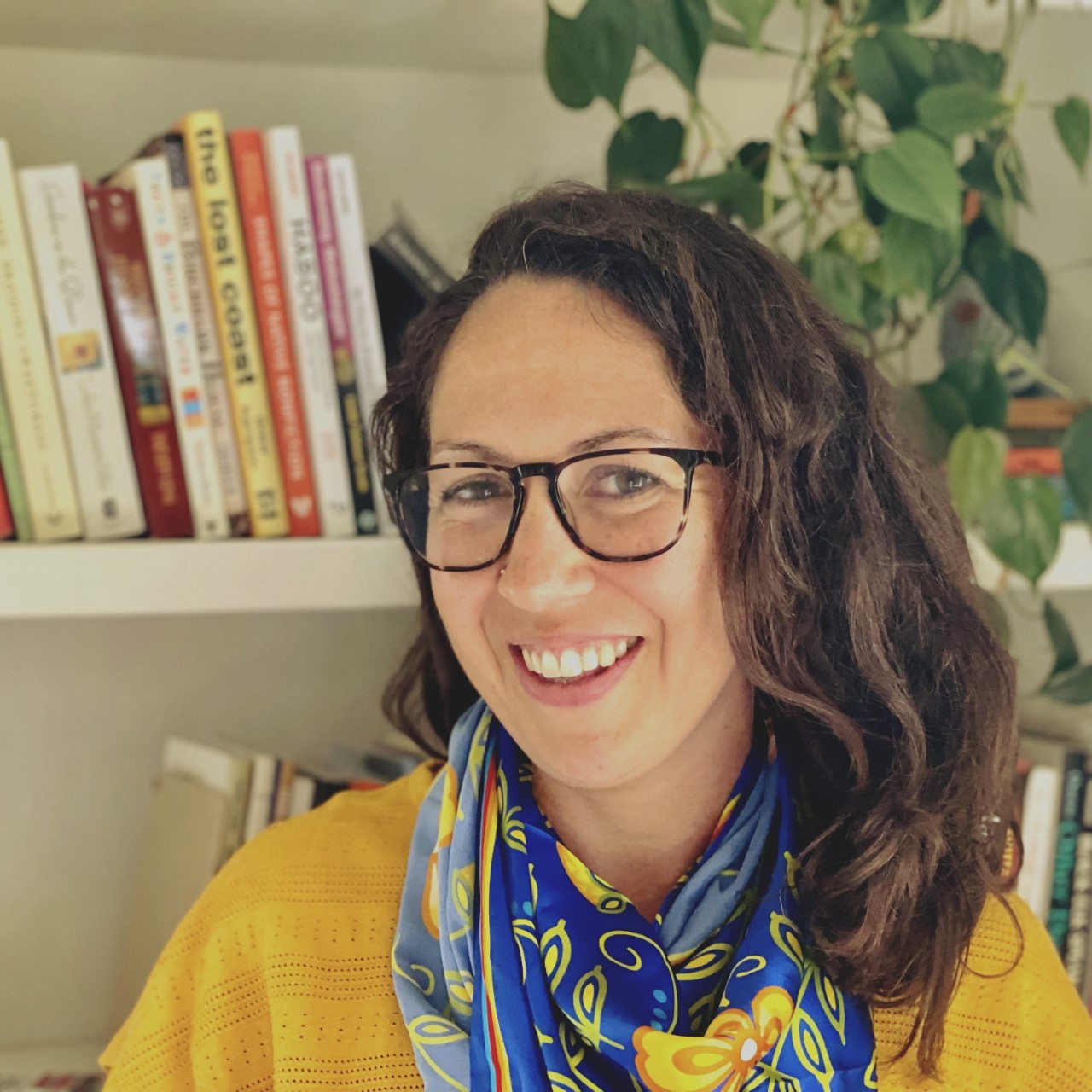
Lydia Heberling
Before coming to Cal Poly, Heberling earned her Pd.D. in English at the University of Washington in 2021. While working on her dissertation, Heberling taught classes on various subjects ranging from writing composition to Indigenous research methods.
Heberling was drawn to California, where she had grown up, after it became the first state in the nation to require ethnic studies in public high school curriculum. “There’s a lot of really exciting energy that is happening in ethnic studies departments across California, and especially at Cal Poly,” Heberling said. “I’m really excited as someone who grew up in California to see this more expansive, intercultural education being promoted and encouraged.”
Heberling will teach Introduction to American Indian Studies (ES 253) each quarter for her first two years at Cal Poly, and she also hopes to add in additional courses soon.
“It is really exciting to me that I get to have 130 new Cal Poly students in my classroom once a quarter for ten weeks to talk about issues in American Indian studies,” Heberling said. “This is what I look forward to –– walking students through that process of unlearning and the re-learning. It’s not their fault that they didn’t ever know this stuff.”
In a broader sense, Heberling is also looking forward to helping fill in the educational gaps that were missing in her own public-school education.
“As someone who identifies –– in all of the complex ways that this is true –– as a settler with some Mexican American and Hispanic background and some of the complicated identity formations that come out of that, we didn’t hear a lot about native culture and presence growing up here,” Heberling said. “So, that’s what my dissertation really focused on, and that’s what I'm hoping to do at Cal Poly.”
Ryan Buyco
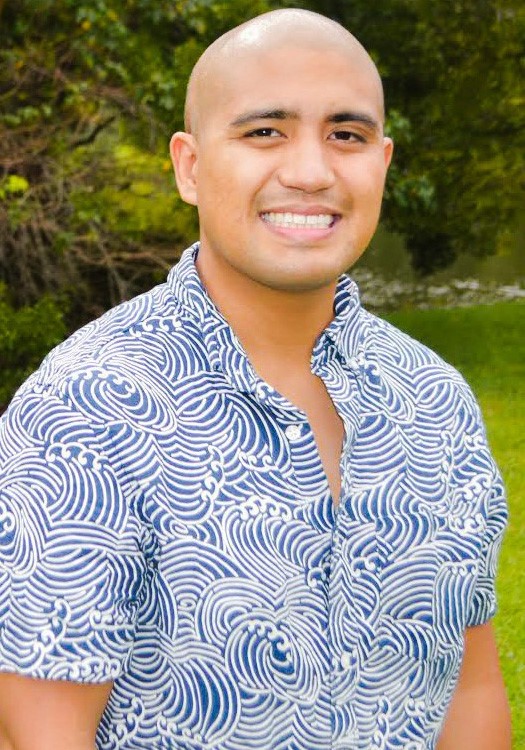
Ryan Buyco
Buyco’s areas of expertise are in Asian American studies, with a focus on the militarized context of Okinawa, which is a small island archipelago in Southern Japan known for its large presence of American military bases. Buyco is currently researching the transpacific trajectories that brought Filipino American men to Okinawa given the large presence U.S. military bases there.
Before moving to San Luis Obispo in early September, Buyco was a post-doctoral fellow in Asian American and Global Asian studies at Colorado College. Prior to this, Buyco completed his PhD in Asian Literature, Religion and Culture at Cornell University in 2019.
Buyco said he was drawn to Cal Poly due to its ‘Learn by Doing’ educational method. “I think this is really in line with my own teaching philosophy, where I provide opportunities for students to connect the classroom to the greater world through various projects” he said.
Buyco will teach Introduction to Asian American Studies, which explores the various sub-fields that make up the larger field of Asian American studies. Buyco is able to touch on U.S. militarization along with many other topics, such as critical refugee studies and settler colonialism. For the final project of the course, students complete a social media project on Instagram (#calpolyasianamstudies) to raise awareness of Asian American studies at Cal Poly and beyond.
“One of the things that I love about teaching this class is that I get to teach students that ‘Asian American’ is not just a descriptive category, but rather, it is an idea that emerges from the Asian American movement in the late 1960s and early 1970s in order to address the history of racism in the United States and American imperialism abroad,” Buyco said.
Buyco’s goals for his time at Cal Poly include helping to grow the Ethnic Studies Department overall, and specifically helping to grow Asian American studies at Cal Poly through developing new course offerings and working with colleagues to hopefully make a new minor in Asian American studies in the near future.
Read the most recent CLA News stories

Political Science Professor R.G. Cravens Selected as Public Fellow for Public Religion Research Institute’s New Initiative
Dec 2, 2021
By Sophia Lincoln
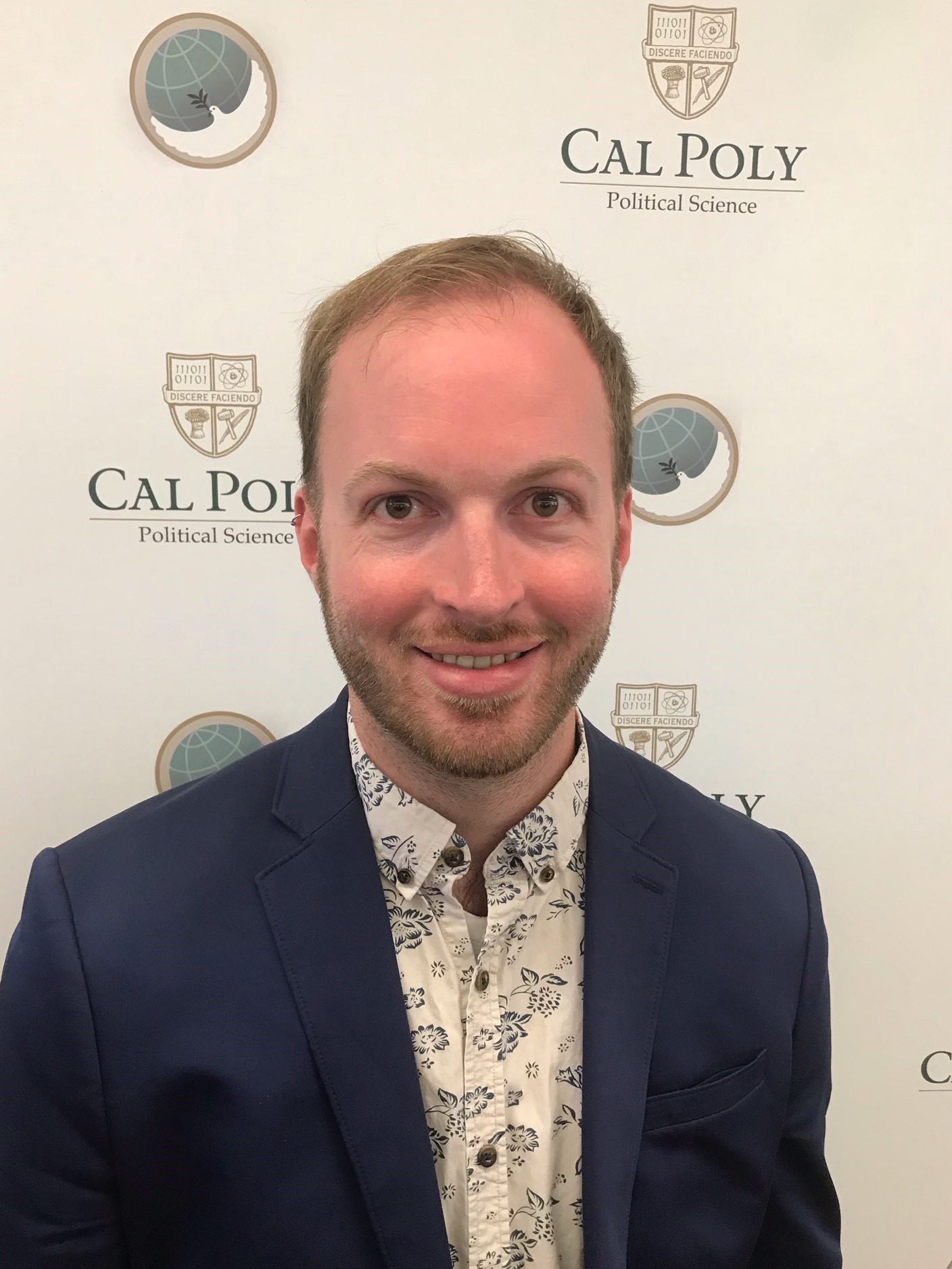
R.G. Cravens
Professor R.G. Cravens will be one of 16 public fellows to pioneer the Public Religion Research Institute’s (PRRI) new Religion and Renewing Democracy initiative.
Cravens, along with three other professors from universities across the country, will specialize in the LGBTQ Rights section of the new project. The fellowship, which began in October, will last one year, but is renewable for a second.
“What I envisioned doing, as far as this fellowship, was to make information public that fully captures the lived reality of LGBTQ people,” Cravens said. “Most popular depictions — and even scientific studies — often fail to fully capture the experience of religious LGBTQ people.”
Cravens’ research examines the intersection of LGBTQ+ politics and religion, including his work through Cal Poly’s Research, Economic Development and Graduate Education (R-EDGE) Research, Scholarly and Creative Activities (RSCA) Grant for the 2021-2022 year.
This topic also aligns with political science classes Cravens currently teaches at Cal Poly including Critical Issues in American Politics (POLS 338).
“We tend to see what I call the ‘Will and Grace paradigm’ displayed which is that popular depictions of LGBTQ people are often centered on White, cisgender, well-off male characters who live usually in urban areas, and especially who are not religious,” Cravens said. “We also know from the social scientific research that LGBTQ people are religious for the most part – that is, a majority of LGBTQ people do affiliate with some faith tradition, and so, there’s a whole gap in the social scientific literature that doesn’t pay much attention to that intersection.”
Cravens’ new role will include developing research reports and blog posts that PRRI will feature on its website and disseminate to its professional networks.
In addition to conducting new research and making that information available to the public, Cravens said he is also excited for what this opportunity could mean for his own research.
“[PRRI has] surveys going back several years that have indicators for LGBTQ people measuring attitudes and religious behaviors of LGBTQ people and then attitudes about LGBTQ people,” Cravens said. “That will really help me contextualize what I know and what I’m researching.”
Additionally, Cravens will have the opportunity to collaborate on new research with three other professors on his team who also specialize in religion and LGBTQ+ studies.
“We will share what we know with one another, and we’ll try to develop a research plan to learn more information about how religion affects LGBTQ people and policy,” Cravens said. “And it won’t just focus on religious behavior as I do, but the others contribute specializations in sociology and psychology and in the other social sciences like religious studies.”
While the new role opens up various opportunities for Cravens, some of those opportunities may also be extended to Cal Poly students and community members.
“PRRI offers briefings to the public for its new data releases,” Cravens said. “Hopefully, I’ll be able to invite some Cal Poly students.”
Read the most recent CLA News stories

Ethnic Studies Department Welcomes New Assistant Professor Lydia Heberling
Nov 12, 2021
By Sophia Lincoln

Lydia Heberling
The Ethnic Studies Department welcomed Assistant Professor Lydia Heberling as one of CLA’s 2021-22 Ethnic Studies Cluster Hires. This search was designed to attract a group of academics invested in equitable and inclusive teaching and dedicated to scholarly contributions in this area. All have been involved in diversity, equity, and inclusion efforts in their departments, our college, the university, and the community.
Herberling’s areas of expertise are in American Indian literatures, with a focus on the literatures from Indigenous California, as well as the emerging field of critical surf studies. Her most recent work focuses on aesthetic and formal innovations in twentieth and twenty-first-century California Native literatures. She is currently working on an article that examines the relationship between colonialism, catastrophic waters, and surfing in three creative non-fiction works by Indigenous writers.
Before coming to Cal Poly, Heberling earned her Ph.D. in English at the University of Washington in 2021. While working on her dissertation, Heberling taught classes on various subjects, ranging from writing composition to Indigenous research methods.
Heberling was drawn to California, where she had grown up, as it became the first state in the nation to pass a law requiring ethnic studies in public high school curriculum. The new requirement will take effect in 2025. “There’s a lot of really exciting energy that is happening in ethnic studies departments across California, and especially at Cal Poly,” Heberling said. “I’m really excited as someone who grew up in California to see this more expansive, intercultural education being promoted and encouraged.”
Heberling will teach Introduction to American Indian Studies (ES 253) each quarter for her first two years at Cal Poly, and she also hopes to add in additional courses soon. As a part of the cluster hire, the college also looks forward to any new courses she might choose to propose and create in future quarters.
“It is really exciting to me that I get to have 130 new Cal Poly students in my classroom once a quarter for ten weeks to talk about issues in American Indian studies,” Heberling said. “This is what I look forward to –– walking students through that process of unlearning and then re-learning.”
In a broader sense, Heberling is also looking forward to helping fill in the educational gaps that were missing in her own public-school education.
“As someone who identifies –– in all of the complex ways that this is true –– as a settler with some Mexican American and Hispanic background and some of the complicated identity formations that come out of that, we didn’t hear a lot about Native culture and presence growing up here,” Heberling said. “So, that’s what my dissertation focused on, and that’s what I'm hoping to do at Cal Poly.”
Read the most recent CLA News stories

Ethnic Studies Department Welcomes New Assistant Professor Lydia Heberling
Nov 12, 2021
By Sophia Lincoln

Lydia Heberling
In 2021, the Ethnic Studies Department welcomed Assistant Professor Lydia Heberling as one of CLA’s 2021-22 DEI-Focused Cluster Hires. This search was designed to attract a diverse group of academics invested in inclusive teaching and dedicated to scholarly contributions in this area. All have been involved in diversity and inclusion efforts in their departments, our college, the university, and in the community.
Herberling’s areas of expertise are in American Indian literatures, with a focus on the literatures from Indigenous California, as well as the emerging field of critical surf studies. Her most recent work focuses on aesthetic and formal innovations in twentieth and twenty-first century California Native literatures. She is currently working on an article that examines the relationship between colonialism, catastrophic waters and surfing in three creative non-fiction works by Indigenous writers.
Before coming to Cal Poly, Heberling earned her Ph.D. in English at the University of Washington in 2021. While working on her dissertation, Heberling taught classes on various subjects ranging from writing composition to Indigenous research methods.
Heberling was drawn to California, where she had grown up, after it became the first state in the nation to require ethnic studies in public high school curriculum. “There’s a lot of really exciting energy that is happening in ethnic studies departments across California, and especially at Cal Poly,” Heberling said. “I’m really excited as someone who grew up in California to see this more expansive, intercultural education being promoted and encouraged.”
Heberling will teach Introduction to American Indian Studies (ES 253) each quarter for her first two years at Cal Poly, and she also hopes to add in additional courses soon.
“It is really exciting to me that I get to have 130 new Cal Poly students in my classroom once a quarter for ten weeks to talk about issues in American Indian studies,” Heberling said. “This is what I look forward to –– walking students through that process of unlearning and the re-learning. It’s not their fault that they didn’t ever know this stuff.”
In a broader sense, Heberling is also looking forward to helping fill in the educational gaps that were missing in her own public-school education. “As someone who identifies –– in all of the complex ways that this is true –– as a settler with some Mexican American and Hispanic background and some of the complicated identity formations that come out of that, we didn’t hear a lot about native culture and presence growing up here,” Heberling said. “So, that’s what my dissertation really focused on, and that’s what I'm hoping to do at Cal Poly.”




